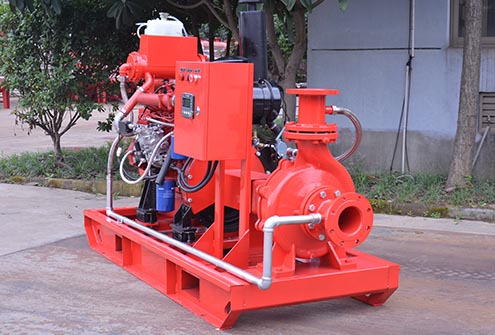How do you test a diesel engine fire pump? & Diesel engine fire pump startup
There are some helpful guides for you to avoid unnecessary and wasteful job and costs caused by improper fire pump testing procedures, Let’s keep on looking the following part.
Diesel Engine Fire Pump Startup
1.Check all equipments if there is no damage during shipping and receiving.
2.Installation all the pumps and controllers according to your situation
3.Unit is properly mounted and secured on a pad. If the pump and engine alignment has been verified, the base may be filled with non-shrink grout.
4.Water supply lines properly flushed in accordance with NFPA 20.
5.NFPA20 standards Suction piping based on the type of pump being installed. (Including but not limited to, potential of straight run prior to entering the pump, eccentric reducer flat side up, OS&Y valves only on suction, etc)
6. All wiring between the particular engine and controller is usually complete and properly sized per the instructions on the inside of the fire pump controller door. Stranded wire must end up being used. 120 volt energy brought to the open fire pump controller along with a individual power source hard wired to the engine block heater. Low fuel degree switch mounted in the particular diesel fuel tank and wired to the fire water pump controller. If louvers are usually being wired to the motor run contact make sure they will meet the required greatest extent amperage rating of the particular fire pump controller. Perform not energize any circuits ahead of the arrival associated with the Pump/Engine/Controller representative.
7. All pump accessories and drains are installed. This consists of the air release valve, gauges, packing drip pumps out, and heat exchanger discharge piped to a flooring drain or frost-free place.
8. Exhaust piping and muffler properly installed, secured and insulated. Exhaust end of contract is screened and/or correctly protected.
9. Diesel fuel tank is properly pitched (1/4” per foot away from the supply valve) and filled with the correct fuel. Fuel lines pipe in schedule 40 black iron only. All vent piping properly installed and terminated outside.
10. Jockey pump is properly wired per the nameplate voltage on the motor and controller.
11. All controller sensing lines installed.
12. All appropriate remote alarms are connected to the fire pump controller. The fire pump representative will be in charge for scheduling the diesel engine representative, as well as the controller representative. Battery electrolyte will be provided the morning test.
When testing diesel fire pumps, you should perform these weekly.
Diesel Fire Pump Testing Procedure
1.Contact the alarm company and tell them to put the system on test for the next hour or so. Telling them you will close some valves and run the pump.
2.Close the main discharge valve of the fire pump, which should prevent any water hammer on the system.
3.Turn off the jockey pump controllers.
4.At this point the fire pump controllers’ selector switch should be in the “auto” position and the engine should be ready to run. Then to drop pressure off the sensing line located on the side of the controller by opening the ball valve and allowing enough water to escape to start the engine. The engine will start and the pump will run. It is very important to check that the cooling loop is discharging water into the floor drain. Let the engine/pump run for 15 minutes. During this run time, to adjust the packing on the fire pump, record the suction and discharge readings, and record the rpm’s of the engine. After 15 minutes turn off the selector switch, the engine should shut down.
5.The next method of starting the pump is a “manual start”. To accomplish, the selector switch must be placed in the manual position. Once the switch is placed in manual you will notice the cooling loop will open and discharge water into floor drain. By pushing either the battery 1 or battery 2 buttons the engine/pump will run. Once the engine has run for 15 minutes turn off the selector switch.
6.Running the pump for the 30 minutes which is required by NFPA 20 every week.
7.With the fire pump controller in the off position, turn the jockey pump controller back to the auto position and open the main control valve on the fire pump. If there was any drop in the system pressure the jockey pump may run. Once the jockey pump has stopped running you may then place the fire pump controller back into the auto position, by turning the selector switch to “auto”.
Do not operate any equipment unless you’re properly trained and qualified. Always wear protective equipments, and follow the latest procedures set forth in local and national codes like the NFPA 25.

